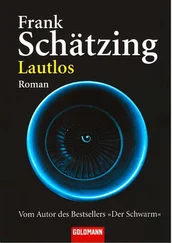Immediately just such a cable stretched between the island and the satellite, into which the apple had suddenly transmuted. Small cabins travelled up and down it.
‘In this context a further consideration arose. Why not extend the cable beyond the centre of gravity? To recap: in geostationary orbit gravity and centrifugal force balance one another out. Beyond it, the relationship between the two forces alters in favour of centrifugal force. A vehicle climbing the cable from the Earth needs to use only a tiny fraction of the energy that would be required to catapult it upwards on a rocket. With increasing altitude the influence of gravity declines in favour of centrifugal force, which means that less and less energy is required until hardly any at all is needed in geostationary orbit. Now, if we imagine the cable being extended to an altitude of 143,800 kilometres, the vehicle could go charging beyond the geostationary orbit: it would be continuously accelerated and would actually gain in energy. A perfect springboard for interstellar travel, to Mars or anywhere else!’
The cabins were now transporting construction components into orbit, to be assembled into a space station. Rocky Rocket loaded up the cabins and started visibly sweating.
‘One way or another the advantages of a space elevator were quite obvious. To carry a kilo of cargo load to an altitude of almost 36,000 kilometres, you no longer needed 50,000 dollars, just 200, and you could also use the lift 365 days a year around the clock. Suddenly the idea of building gigantic space stations and adequately armoured spaceships no longer seemed like a problem. The colonisation of space became a tangible possibility, and inspired the British science-fiction author Arthur C. Clarke to write his novel The Fountains of Paradise , in which he describes the construction of space elevators like this.’
‘But why does the thing have to be built at the equator, of all places?’ asked Rocky Rocket, wiping the sweat from his tip. ‘Why not at the North Pole or the South Pole, where it’s nice and cool? And why in the middle of the stupid sea and not, for example in’ – his eyes gleamed, he took a few dance steps and clicked his fingers – ‘Las Vegas?’
‘I’m not sure if you seriously want to set off for space surrounded by penguins,’ Julian replied sceptically. ‘But it wouldn’t work anyway. It’s only at the equator that you can exploit the Earth’s rotation to achieve a maximum of centrifugal force. It’s only there that geostationary objects are possible.’ He thought for a moment. Then he said, ‘Listen, I want to explain something to you. Imagine you’re a hammer-thrower.’
The little rocket seemed to like the idea. He threw out his chest and tensed his muscles.
‘Where’s the hammer?’ he crowed. ‘Bring it here!’
‘It’s not a real hammer these days, idiot, that’s just its name. These days the hammer is a metal ball on a steel cable.’ Julian conjured the object out of nowhere and pressed the handle firmly into both of Rocky’s hands. ‘Now you have to spin on your axis with your arms outstretched.’
‘Why?’
‘To speed up the hammer. Let it spin.’
‘Heavy, isn’t it?’ Rocky groaned and pulled on the steel cable. He started to spin around, faster and faster. The cable tightened, the sphere lifted from the ground and reached a horizontal position. ‘Can I throw it now?’ he panted.
‘In a minute. For now you’ve just got to imagine you’re not Rocky, you’re the planet Earth. Your head is the North Pole, your feet are the South Pole. In between them is the axis that you’re spinning around. If that’s the case, what’s the middle of your body?’
‘Huh? What? The equator, obviously.’
‘Well done.’
‘Can I throw it now?’
‘Wait. From the middle of your body, the equator, the hammer swings out, pulled tight by centrifugal force, just as the cable of the space elevator must be pulled tight.’
‘I get it. Can I do it?’
‘Just one moment! Your hands are, in a sense, our Pacific islands, the metal sphere is the satellite or the space station in geostationary orbit. That clear?’
‘It’s clear.’
‘Okay. Now raise your hands. Go on spinning, but lift them high above your head.’
Rocky followed the instructions. The steel cable immediately lost its tension and the ball came crashing down on the little rocket. He rolled his eyes, staggered and fell to the ground.
‘Do you think you get the principle?’ Julian asked sympathetically.
Rocky waved a white flag.
‘Then that’s all sorted out. Practically every point on the equator is suitable for the space elevator, but there are a few things you have to take into account. The anchor station, the ground floor, so to speak, should be in an area that is free of storms, strong winds and electrical discharges, with no air traffic and a generally clear sky. Most such places are found in the Pacific. One of them lies 550 kilometres to the west of Ecuador, and is the place where we are right now – the Isla de las Estrellas!’
Suddenly Julian was standing on the viewing terrace of the Stellar Island Hotel. Far outside the floating platform could be seen, and the two cables stretching from the inside of the Earth station into the endless blue.
‘As you can see, we have built not one, but two lifts. Two cables stretch in parallel into orbit. But even a few years ago it seemed doubtful whether we would ever experience this sight. Without the research work of Orley Enterprises the solution would probably have had to wait for several more years, and all this’ – Julian spread his arms out – ‘would not exist.’
The illusion vanished; Julian floated in Bible-blackness.
‘The problem was to find a material from which a cable 35,786 kilometres long could be manufactured. It had to be ultra-light and at the same time ultra-stable. Steel was out of the question. Even the highest quality steel cable would break under its own weight alone after only thirty or forty kilometres. Some people came up with the idea of spiders’ silk, given that it’s four times more resilient than steel, but even that wouldn’t have given the cable the requisite tensile strength, let alone the fact that for 35,786 kilometres of cable you’d need one hell of a lot of spiders. Frustrating! The anchor station, the space station, the cabins, all of that seemed manageable. But the concept seemed to founder on the cable – until the start of the millennium, when a revolutionary new material was discovered: carbon nanotubes.’
A gleaming, three-dimensional grid structure began to rotate in the black. Its tubal form vaguely resembled the kind of bow net that people use for fishing.
‘This object is actually ten thousand times thinner than a human hair. A tiny tube, constructed from carbon atoms in a honeycomb arrangement. The smallest of these tubes has a diameter of less than one nanometre. Its density is one-sixth that of steel, which makes it very light, but at the same time it has a tensile strength of about 45 gigapascals, whereas at 2 gigapascals steel crumbles like a cookie. Over the years ways were found to bundle the tubes together and spin them into threads. In 2004 researchers in Cambridge produced a thread 100 metres long. But it seemed doubtful whether such threads could be woven into larger structures, particularly since experiments showed that the tensile strength of the thread declined dramatically in comparison with individual tubes. A kind of weaving flaw was introduced by missing carbon atoms, and besides, carbon is subject to oxidation. It erodes, so the threads needed to be coated.’
Julian paused.
‘For many years Orley Enterprises invested in research into the question of how this flaw could be remedied. Not only were we able to replace the missing atoms, we also managed to enhance the tensile strength of the cables to 65 gigapascals through cross-connections! We found ways to layer them and protect them against meteorites, space junk, natural oscillations and the destructive effect of atomic oxygen. They are just one metre wide but flatter than a human hair, which is why they seem to disappear when you see them from the side. At a distance of 140,000 kilometres from Earth, where they end, we have connected them to a small asteroid, which acts as a counterweight. In future we want to accelerate spaceships along that stretch of ribbon in such a way that they could fly to Mars, or beyond, without any notable outlay of energy.’ He smiled. ‘In geostationary orbit, however, we have built a space station unlike anything that has ever existed before: the OSS, the Orley Space Station, accessible within three hours by space elevator: research station, space station and port! All manned and unmanned transfer flights to the Moon start from there. In turn, compressed helium-3 from the mining sites comes to OSS, is loaded onto the space elevator and sent to Earth, so that the prospect of ten billion people being provided with unlimited supplies of clean and affordable energy is becoming more and more of a reality every day. We can now say that helium-3 has supplanted the age of fossil fuels, because the necessary fusion reactors required have also been developed to market maturity by Orley Enterprises. The significance of oil and gas has dramatically declined. The plundering of our home planet is coming to an end. Oil wars will be a thing of the past. None of this would have been possible without the development of the space elevator, but we have taken to its conclusion the dream that Konstantin Tsiolkovsky dreamed – and made it reality!’
Читать дальше












